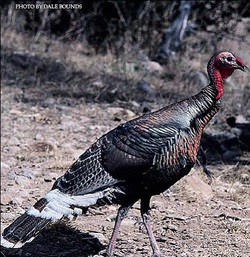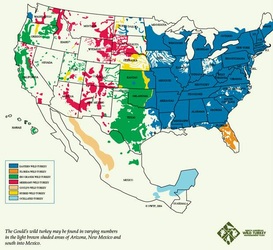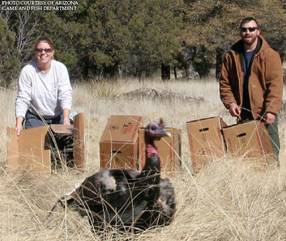Gould’s Wild Turkey
(Meleagris gallopavo mexicana)
NWTF Wildlife Bulletin No. 5
by Mary C. Kennamer
(full document as it appears on the NWTF Page (below))
| goulds-bulletin_5_9-9-09.pdf | |
| File Size: | 1100 kb |
| File Type: | |
Gould’s Wild Turkey

The fifth recognized, but least known, wild turkey subspecies is the Gould’s found in the southern portions of Arizona and New Mexico as well as northern Mexico. It was first described by J. Gould in 1856 during his travels in Mexico.
Like the Merriam’s, the Gould’s is a bird of the mountains. It exists in very small numbers in Arizona and New Mexico along the U.S./Mexico border, but is apparently abundant in the northwestern portions of Mexico. The Arizona Game and Fish Department, U.S. Forest Service, the Centro Ecologico de Sonora, the National Wild Turkey Federation, and other agencies are working cooperatively to reintroduce a strong Gould’s population first into Arizona and then into other states where suitable range exists.
Like the Merriam’s, the Gould’s is a bird of the mountains. It exists in very small numbers in Arizona and New Mexico along the U.S./Mexico border, but is apparently abundant in the northwestern portions of Mexico. The Arizona Game and Fish Department, U.S. Forest Service, the Centro Ecologico de Sonora, the National Wild Turkey Federation, and other agencies are working cooperatively to reintroduce a strong Gould’s population first into Arizona and then into other states where suitable range exists.
The Gould’s turkey is the largest of the 5 subspecies and somewhat resembles the Merriam’s turkey. They have longer legs, larger feet, and larger center tail feathers than any of the other wild turkey subspecies in North America. Gould’s differ by having distinctive white tips on the tail feathers and tail rump coverts which usually separate to show an “eyelash” appearance. Lower back and rump feathers have copper and greenish-golden reflections, not like the faintly iridescent velvety black found on the Merriam’s. Gould’s body plumage is said to be somewhat blue-green in coloration. Adult females have a less pronounced metallic greenish and reddish sheen and are more purplish.
The Sierra Madre Occidental Mountains in Mexico are the center of the Gould’s turkey Mexican range, extending south
from the U.S./Mexico border. Populations exist in Chihuahua, Sonora, Sinaloa, Durango, Zacatecas, Nayarit, Jalisco
and Coahuila. In the U.S. Gould’s turkeys are found in the Animas and San Luis mountains of New Mexico and in the
Peloncillo Mountains of New Mexico and Arizona. Mountain ranges where Gould’s are found orient north and south with
elevations ranging from 4,500 to 6,500 feet in the U.S. and over 9,800 feet in Mexico. Turkey habitat can be rough with
steep and rocky canyons.
Gould’s turkey range in the U.S. has a continental climate characterized by wide daily and annual fluctuations in distinct
seasonal changes with hot summers and mild winters. Average annual precipitation is 18 inches—more than half falling
between July and September. About 10 inches of snowfall in winter accounts for the rest. In Mexico climate conditions are
about the same as those found in the U.S., however, winters are colder and there is more snow in the higher mountains.
Breeding behavior is triggered primarily by the increasing day length in spring, but unusually warm or cold spells may
accelerate or slow breeding activity. This behavior can begin while birds are still in large winter flocks prior to separating
as individuals or into small groups.
The basic social organization of these flocks is determined by a pecking order with the most dominant bird at the top and the least on the bottom. Males and females have separate hierarchies, and there can be pecking orders within and between flocks of the same sex; while stable pecking orders within flocks of the same sex seem to be common to all wild turkey subspecies. Turkeys have home ranges, not territories where individuals defend space within a given habitat from other members of the same sex. Instead they fight for dominance recognizing individuals within the pecking order while sharing overlapping home ranges.
Courtship behavior patterns include gobbling and strutting by the males. Gobbling attracts hens to males who court the hens by strutting. If the hen selects the gobbler for mating she crouches, which signals the male to copulate. The first peak of gobbling activity is associated with the beginning of the breeding period when gobblers are searching for hens. The second
peak occurs a few weeks later, when most hens begin incubation. Gobbling activity for the Gould’s has been documented to begin in April and May in Mexico and from late April into June in New Mexico. Later gobbling by the subspecies seems to coincide with the plant green-up in the Gould’s habitat. The gobble of the male is distinguished by a lower frequency than either of the other 2 western subspecies.
Hens become secretive while searching for a site near water to nest prior to laying eggs. Laying hens may continue to feed with other hens and mate with gobblers, but this social activity will be away from the nest site. Water is a key habitat component and a limiting factor in Gould’s turkey range. The existence of livestock ponds and watering facilities is sometimes the only source of water for the subspecies.
Nests are shallow depressions formed mostly by scratching, squatting, and laying eggs rather than by purposeful construction. The arrangement of twigs and leaves is minimal in sites chosen for their moderately dense understory which still allows the hen a view but gives protection from avian predators.
Laying a clutch of 10 - 12 eggs takes about 2 weeks and unincubated eggs are usually covered with leaves. Continuous incubation begins about the time the last egg is laid at which time the hen no longer tries to conceal her eggs when she leaves for short periods to feed.
The hen will incubate for 26 – 28 days sitting quietly and moving about once an hour to turn the eggs. Actual hatching begins in early to late June with pipping—the poult rotating within the shell, chipping a complete break around the large end of the egg.
(See Bulletin for the full story)
The Sierra Madre Occidental Mountains in Mexico are the center of the Gould’s turkey Mexican range, extending south
from the U.S./Mexico border. Populations exist in Chihuahua, Sonora, Sinaloa, Durango, Zacatecas, Nayarit, Jalisco
and Coahuila. In the U.S. Gould’s turkeys are found in the Animas and San Luis mountains of New Mexico and in the
Peloncillo Mountains of New Mexico and Arizona. Mountain ranges where Gould’s are found orient north and south with
elevations ranging from 4,500 to 6,500 feet in the U.S. and over 9,800 feet in Mexico. Turkey habitat can be rough with
steep and rocky canyons.
Gould’s turkey range in the U.S. has a continental climate characterized by wide daily and annual fluctuations in distinct
seasonal changes with hot summers and mild winters. Average annual precipitation is 18 inches—more than half falling
between July and September. About 10 inches of snowfall in winter accounts for the rest. In Mexico climate conditions are
about the same as those found in the U.S., however, winters are colder and there is more snow in the higher mountains.
Breeding behavior is triggered primarily by the increasing day length in spring, but unusually warm or cold spells may
accelerate or slow breeding activity. This behavior can begin while birds are still in large winter flocks prior to separating
as individuals or into small groups.
The basic social organization of these flocks is determined by a pecking order with the most dominant bird at the top and the least on the bottom. Males and females have separate hierarchies, and there can be pecking orders within and between flocks of the same sex; while stable pecking orders within flocks of the same sex seem to be common to all wild turkey subspecies. Turkeys have home ranges, not territories where individuals defend space within a given habitat from other members of the same sex. Instead they fight for dominance recognizing individuals within the pecking order while sharing overlapping home ranges.
Courtship behavior patterns include gobbling and strutting by the males. Gobbling attracts hens to males who court the hens by strutting. If the hen selects the gobbler for mating she crouches, which signals the male to copulate. The first peak of gobbling activity is associated with the beginning of the breeding period when gobblers are searching for hens. The second
peak occurs a few weeks later, when most hens begin incubation. Gobbling activity for the Gould’s has been documented to begin in April and May in Mexico and from late April into June in New Mexico. Later gobbling by the subspecies seems to coincide with the plant green-up in the Gould’s habitat. The gobble of the male is distinguished by a lower frequency than either of the other 2 western subspecies.
Hens become secretive while searching for a site near water to nest prior to laying eggs. Laying hens may continue to feed with other hens and mate with gobblers, but this social activity will be away from the nest site. Water is a key habitat component and a limiting factor in Gould’s turkey range. The existence of livestock ponds and watering facilities is sometimes the only source of water for the subspecies.
Nests are shallow depressions formed mostly by scratching, squatting, and laying eggs rather than by purposeful construction. The arrangement of twigs and leaves is minimal in sites chosen for their moderately dense understory which still allows the hen a view but gives protection from avian predators.
Laying a clutch of 10 - 12 eggs takes about 2 weeks and unincubated eggs are usually covered with leaves. Continuous incubation begins about the time the last egg is laid at which time the hen no longer tries to conceal her eggs when she leaves for short periods to feed.
The hen will incubate for 26 – 28 days sitting quietly and moving about once an hour to turn the eggs. Actual hatching begins in early to late June with pipping—the poult rotating within the shell, chipping a complete break around the large end of the egg.
(See Bulletin for the full story)

